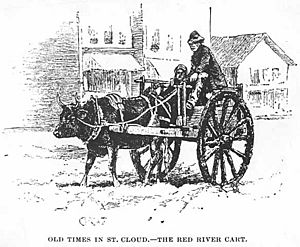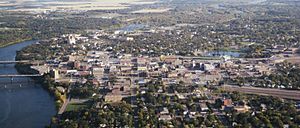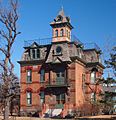St. Cloud, Minnesota facts for kids
Quick facts for kids
St. Cloud
|
|
|---|---|
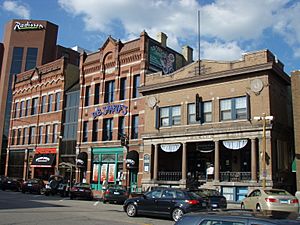
Buildings on 5th Avenue in downtown in 2008
|
|
| Nickname(s):
"The Granite City"
|
|
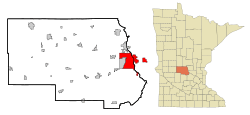
Location within Stearns County and the state of Minnesota
|
|
| Country | United States |
| State | Minnesota |
| Counties | Stearns, Benton, Sherburne |
| Founded | 1856 |
| Named for | Clodoald, Saint-Cloud |
| Area | |
| • City | 41.23 sq mi (106.78 km2) |
| • Land | 40.17 sq mi (104.04 km2) |
| • Water | 1.06 sq mi (2.74 km2) |
| Elevation | 1,027 ft (313 m) |
| Population
(2020)
|
|
| • City | 68,881 |
| • Estimate
(2022)
|
69,568 |
| • Rank | US: 542nd MN: 12th |
| • Density | 1,714.78/sq mi (662.08/km2) |
| • Urban | 117,638 (US: 290th) |
| • Metro | 201,868 (US: 229th) |
| Time zone | UTC-6 (Central (CST)) |
| • Summer (DST) | UTC-5 (CDT) |
| ZIP codes |
56301, 56302, 56303, 56304, 56393, 56397, 56398
|
| Area code(s) | 320 |
| FIPS code | 27-56896 |
| GNIS feature ID | 2396483 |
St. Cloud or Saint Cloud (/ˈseɪnt klaʊd/) is a city in the state of Minnesota, USA. It is the biggest city in the central part of Minnesota. In 2020, about 68,881 people lived there. This makes it the 12th largest city in Minnesota. St. Cloud is the main city of Stearns County. It was named after a city in France called Saint-Cloud, which is near Paris. That French city was named after a monk from the 6th century named Clodoald.
St. Cloud is mostly in Stearns County. But it also reaches into Benton and Sherburne counties. The Mississippi River flows through the city. St. Cloud is the center of a larger urban area. Nearby cities like Waite Park, Sauk Rapids, and Sartell are right next to it. The whole St. Cloud metropolitan area had about 199,671 people in 2020.
St. Cloud is about 65 miles (105 km) northwest of the Twin Cities (Minneapolis–St. Paul). You can get there by major highways like Interstate 94 and U.S. Highway 10. The St. Cloud metropolitan area includes Stearns and Benton Counties.
St. Cloud State University is Minnesota's third-largest public university. It is located near the Mississippi River. The river here has about 30 undeveloped islands called the Beaver Islands. These islands are great for kayaking and canoeing when the river is safe.
St. Cloud also has its own hydroelectric dam on the Mississippi River. This dam makes nearly nine megawatts of electricity. This is about 10% of all the electricity made by the 11 Mississippi hydro dams in Minnesota.
Contents
History of St. Cloud
For thousands of years, different groups of indigenous peoples lived in the area that is now St. Cloud. Later, French traders from New France met the Ojibwe and Dakota people. They traded furs with the Native Americans.
The Minnesota Territory was set up in 1849. People started to settle in the St. Cloud area after a treaty was signed with the Dakota people in 1851.
How St. Cloud Got Its Name
A settler named John L. Wilson came from Maine. He named the settlement St. Cloud. He named it after Saint-Cloud, a suburb of Paris, France. This was where Napoleon had his favorite palace.
St. Cloud was a stop on the Red River Trails. These trails were used by traders to move furs between Canada and St. Paul. The city of St. Cloud officially became a city in 1856.
Early Settlements and People
St. Cloud grew from three different settlements. These were called Upper Town, Middle Town, and Lower Town. Settlers started these towns in 1853.
- Middle Town was mostly settled by German Catholic immigrants. A Catholic priest named Father Francis Xavier Pierz encouraged them to move there.
- Lower Town was founded by settlers from New England and the mid-Atlantic states. These settlers were against slavery.
- Upper Town was started by General Sylvanus Lowry. He was from Kentucky and owned slaves. Even though Minnesota was a free territory, he brought slaves with him.
A newspaper editor named Jane Grey Swisshelm was against slavery. She often wrote articles criticizing Lowry. At one point, Lowry's group broke into her office and threw her printing press into the Mississippi River.
When the American Civil War started, most Southerners left the St. Cloud area. They took their slaves with them. By 1860, there were very few slaves left in the community.
Many young men from St. Cloud fought in the Union Army during the Civil War. After the war, they helped raise money for a statue of President Abraham Lincoln. This statue is still in St. Cloud today.
From 1864 to 1866, Stephen Miller was the governor of Minnesota. He was the only person from St. Cloud to hold this job. He was a businessman, lawyer, and against slavery.
Growth and Industry
Steamboats used to stop regularly at St. Cloud for trade. This stopped when the Coon Rapids Dam was built in 1912–14.
Since the 1880s, people have been quarrying Granite in the area. This is why St. Cloud is known as "The Granite City."
Geography and Climate
St. Cloud covers about 41 square miles (106 square kilometers). Most of this is land, and a small part is water.
The city is built on both sides of the Mississippi River. The Sauk River also runs along its northern edge.
Just south of downtown is Lake George. It is 7 acres (2.8 hectares) big and 35 feet (11 meters) deep. The city has worked to keep the lake clean.
The granite rock found in the area is very old, about 1.7 billion years old. The land around St. Cloud was shaped by glaciers many times.
St. Cloud's Weather
St. Cloud has a humid continental climate. This means it has warm summers and cold winters with a lot of snow.
- The average temperature in January is about 11.6°F (-11.3°C).
- The average temperature in July is about 70.3°F (21.3°C).
- The hottest temperature ever recorded was 107°F (42°C).
- The coldest temperature ever recorded was -43°F (-42°C).
| Climate data for St. Cloud Regional Airport, Minnesota (1991–2020 normals, extremes 1894–present) | |||||||||||||
|---|---|---|---|---|---|---|---|---|---|---|---|---|---|
| Month | Jan | Feb | Mar | Apr | May | Jun | Jul | Aug | Sep | Oct | Nov | Dec | Year |
| Record high °F (°C) | 56 (13) |
59 (15) |
81 (27) |
96 (36) |
105 (41) |
102 (39) |
107 (42) |
105 (41) |
106 (41) |
90 (32) |
76 (24) |
63 (17) |
107 (42) |
| Mean maximum °F (°C) | 41.9 (5.5) |
45.1 (7.3) |
61.0 (16.1) |
78.1 (25.6) |
88.3 (31.3) |
92.4 (33.6) |
92.6 (33.7) |
90.8 (32.7) |
87.2 (30.7) |
79.3 (26.3) |
59.9 (15.5) |
44.4 (6.9) |
95.1 (35.1) |
| Mean daily maximum °F (°C) | 20.7 (−6.3) |
25.7 (−3.5) |
38.5 (3.6) |
54.3 (12.4) |
67.8 (19.9) |
77.2 (25.1) |
81.6 (27.6) |
79.2 (26.2) |
71.0 (21.7) |
55.9 (13.3) |
39.3 (4.1) |
25.8 (−3.4) |
53.1 (11.7) |
| Daily mean °F (°C) | 11.8 (−11.2) |
16.1 (−8.8) |
29.2 (−1.6) |
43.3 (6.3) |
56.2 (13.4) |
66.0 (18.9) |
70.3 (21.3) |
67.7 (19.8) |
59.5 (15.3) |
45.7 (7.6) |
30.9 (−0.6) |
17.8 (−7.9) |
42.9 (6.1) |
| Mean daily minimum °F (°C) | 2.9 (−16.2) |
6.5 (−14.2) |
19.8 (−6.8) |
32.4 (0.2) |
44.6 (7.0) |
54.8 (12.7) |
58.9 (14.9) |
56.3 (13.5) |
48.0 (8.9) |
35.5 (1.9) |
22.6 (−5.2) |
9.8 (−12.3) |
32.7 (0.4) |
| Mean minimum °F (°C) | −22.5 (−30.3) |
−16.2 (−26.8) |
−5.0 (−20.6) |
16.7 (−8.5) |
30.1 (−1.1) |
41.3 (5.2) |
47.4 (8.6) |
44.3 (6.8) |
31.1 (−0.5) |
19.6 (−6.9) |
3.2 (−16.0) |
−14.8 (−26.0) |
−25.1 (−31.7) |
| Record low °F (°C) | −43 (−42) |
−40 (−40) |
−32 (−36) |
−3 (−19) |
18 (−8) |
32 (0) |
40 (4) |
33 (1) |
18 (−8) |
5 (−15) |
−23 (−31) |
−41 (−41) |
−43 (−42) |
| Average precipitation inches (mm) | 0.67 (17) |
0.76 (19) |
1.57 (40) |
2.61 (66) |
3.66 (93) |
3.75 (95) |
3.60 (91) |
4.00 (102) |
3.01 (76) |
2.61 (66) |
1.37 (35) |
0.88 (22) |
28.49 (724) |
| Average snowfall inches (cm) | 8.8 (22) |
8.9 (23) |
8.2 (21) |
4.7 (12) |
0.1 (0.25) |
0.0 (0.0) |
0.0 (0.0) |
0.0 (0.0) |
0.0 (0.0) |
1.0 (2.5) |
6.9 (18) |
9.3 (24) |
47.9 (122) |
| Average precipitation days (≥ 0.01 in) | 7.8 | 6.4 | 8.3 | 9.7 | 11.4 | 12.3 | 10.6 | 9.3 | 10.0 | 9.7 | 7.3 | 7.7 | 110.5 |
| Average snowy days (≥ 0.1 in) | 8.5 | 6.4 | 5.0 | 2.2 | 0.2 | 0.0 | 0.0 | 0.0 | 0.0 | 0.9 | 4.6 | 8.2 | 36.0 |
| Average relative humidity (%) | 70.0 | 66.1 | 67.3 | 65.8 | 62.0 | 67.3 | 67.7 | 69.5 | 73.5 | 68.3 | 73.3 | 75.2 | 68.8 |
| Average dew point °F (°C) | −0.9 (−18.3) |
4.6 (−15.2) |
17.4 (−8.1) |
30.6 (−0.8) |
40.5 (4.7) |
52.0 (11.1) |
59.2 (15.1) |
56.7 (13.7) |
48.4 (9.1) |
36.1 (2.3) |
23.0 (−5.0) |
12.7 (−10.7) |
31.7 (−0.2) |
| Source: NOAA (relative humidity and dew point 1961–1990) | |||||||||||||
People and Population
| Historical population | |||
|---|---|---|---|
| Census | Pop. | %± | |
| 1870 | 2,161 | — | |
| 1880 | 2,462 | 13.9% | |
| 1890 | 7,686 | 212.2% | |
| 1900 | 8,663 | 12.7% | |
| 1910 | 10,600 | 22.4% | |
| 1920 | 15,873 | 49.7% | |
| 1930 | 21,000 | 32.3% | |
| 1940 | 24,173 | 15.1% | |
| 1950 | 28,410 | 17.5% | |
| 1960 | 32,415 | 14.1% | |
| 1970 | 39,691 | 22.4% | |
| 1980 | 42,566 | 7.2% | |
| 1990 | 48,812 | 14.7% | |
| 2000 | 59,108 | 21.1% | |
| 2010 | 65,842 | 11.4% | |
| 2020 | 68,881 | 4.6% | |
| 2022 (est.) | 69,568 | 5.7% | |
| U.S. Decennial Census 2020 Census |
|||
Who Lives in St. Cloud?
| Race/ethnicity | ||||||
|---|---|---|---|---|---|---|
| 2000 | 2010 | 2020 | ||||
| Number | % | Number | % | Number | % | |
| White alone | 53,857 | 91.12% | 54,854 | 83.31% | 46,641 | 67.71% |
| Black alone | 1,378 | 2.33% | 5,101 | 7.75% | 13,180 | 19.13% |
| Native American alone | 402 | 0.68% | 398 | 0.61% | 337 | 0.49% |
| Asian alone | 1,833 | 3.10% | 2,393 | 3.64% | 2,404 | 3.49% |
| Pacific Islander alone | 31 | 0.05% | 16 | 0.03% | 51 | 0.07% |
| Other race alone | 60 | 0.10% | 54 | 0.08% | 314 | 0.46% |
| Two or more races | 762 | 1.29% | 1,429 | 2.17% | 2,116 | 3.07% |
| Hispanic or Latino | 784 | 1.33% | 1,597 | 2.43% | 2,838 | 4.12% |
| Total | 59,107 | 100.00% | 65,842 | 100.00% | 68,881 | 100.00% |
St. Cloud's population has changed a lot in the last 20 years. In 2000, most people were White. By 2020, this group was about 67% of the population. The number of Black or African American residents grew a lot. It went from 2% in 2000 to almost 20% in 2020. The number of Hispanic or Latino people also nearly tripled.
New Residents and Cultures
St. Cloud has always welcomed new people. In the past, many German, Polish, and Irish immigrants came here. More recently, many new residents have come from Africa, especially from Somalia. Some estimates say that up to 25,000 Somalis live in St. Cloud and nearby cities. About half of them moved here between 2009 and 2013. About 15% of the local school district's students are Somali. Many Somalis are also in high schools, colleges, and universities.
Top Employers in St. Cloud
Here are some of the biggest employers in St. Cloud:
| # | Employer | # of Employees |
|---|---|---|
| 1 | *CentraCare Health System St. Cloud Hospital | 6,316 |
| 2 | State of Minnesota / St. Cloud State University | 2,082 |
| 3 | St. Cloud VA Health Care System | 1,692 |
| 4 | ** St. Cloud School District | 1,126 |
| 5 | Fullfillment Distribution Center | 684 |
| 6 | *** Stearns County | 661 |
| 7 | New Flyer of America Inc. | 646 |
| 8 | Capital One | 701 |
| 9 | Coborns Inc. | 673 |
| 10 | Anderson Trucking | 625 |
Figures reflect only full-time employees. * Includes employees at sites outside of St. Cloud. ** Business has significant part-time staff in addition to the full-time employee count indicated. *** Does not include Stearns County full-time employees now working at county satellite offices outside of the City of St. Cloud.
Fun Things to Do in St. Cloud
In 2019, St. Cloud won three first-place awards from the International Awards for Liveable Communities (LivCom). This award recognizes cities that are great places to live. St. Cloud was praised for improving its parks and trails. It also won for its arts, culture, and community involvement.
The St. Cloud River's Edge Convention Center hosts many events. These include conferences, shows, and meetings.
Places to Visit
- Cathedral of Saint Mary: This is the largest church in the community. It was built in the 1920s.
- St. Cloud State University: A large public university.
- Great River Regional Library: A library system with almost 1 million books, CDs, and DVDs.
- Munsinger Gardens and Clemens Gardens: Beautiful flower gardens that started in the 1930s. They are ranked among the best public gardens in the nation.
- Quarry Park and Nature Preserve: A public park in nearby Waite Park. It has 20 granite quarries, hiking, biking, and ski trails.
- Paramount Theatre and Visual Arts Center: A restored theater built in 1921.
- Stearns History Museum: This museum has exhibits, a research area, and a nature park.
- Minnesota Amateur Baseball Hall of Fame: A place dedicated to Minnesota's baseball history.
- St. Cloud Regional Airport: An airport with flights and other operations.
- Minnesota Correctional Facility – St. Cloud: A prison built in 1889.
- Shopping Malls:
- Midtown Square Mall
- Crossroads Center
Sports in St. Cloud
St. Cloud is home to several sports teams and clubs:
- St. Cloud State University Ice Hockey: The men's and women's teams play in Division I college hockey. The men's team reached the championship game in 2021. They play at the Herb Brooks National Hockey Center.
- St. Cloud Norsemen: A junior hockey team.
- Granite City Lumberjacks: Another junior hockey team in nearby Sauk Rapids.
- St. Cloud Rox: A college summer baseball team. They play at Joe Faber Field.
- Saint Cloud Area Roller Dolls: A flat-track roller derby league.
- Saint Cloud River Runners club: They organize the Lake Wobegon Trail Marathon. This race is a good way for runners to qualify for the Boston Marathon.
- Granite City FC: A minor league soccer team.
Parks and Outdoor Fun
The city has 95 parks, covering over 1,400 acres (5.7 square kilometers). They range from small neighborhood parks to very large ones. Whitney Memorial Park is the largest developed park. It has a recreation center for seniors, a dog park, and many sports fields.
Education in St. Cloud
Primary home languages of St. Cloud Public School students English (62.5%) Somali (27.9%) Spanish (4.5%) Vietnamese (0.78%) Other languages (4.3%)
Most of St. Cloud is part of the St. Cloud Public School District. This district serves St. Cloud and several nearby towns. It has eight elementary schools and two main public high schools:
- St. Cloud Technical High School
- St. Cloud Apollo High School
Both public high schools offer many Advanced Placement (AP) courses. St. Cloud also has a private high school, Cathedral High School. Other schools include St. Robert Bellarmine's Academy and St. Cloud Christian School.
Colleges and Universities
St. Cloud has several places for higher education:
- St. Cloud State University: Minnesota's third-largest university.
- St. Cloud Technical and Community College (SCTCC)
- Rasmussen College
Nearby, you can also find a campus of the College of St. Scholastica in Sartell. The College of St. Benedict and St. John's University are in St. Joseph and Collegeville.
Media in St. Cloud
The main local newspaper is the St. Cloud Times.
St. Cloud is part of the Twin Cities television market. There are also local TV stations like KPXM-TV and WCMN-LD. St. Cloud State University students run a cable TV channel called UTVS. It shows local news.
Radio Stations
St. Cloud has many radio stations, both FM and AM. They play different types of music and news.
FM Radio Stations
| FM radio stations | ||||
|---|---|---|---|---|
| Frequency | Call sign | Name | Format | Owner |
| 88.1 88.1 HD-2 |
KVSC | Radio X |
College Radio Alternative Rock |
St. Cloud State University |
| 88.9 88.9 HD-2 |
KNSR | MPR News 89.3 The Current |
Public Radio Adult Album Alternative |
Minnesota Public Radio |
| 89.5 | K208DV (KLRD-FM Translator) |
Air 1 | Contemporary Christian | Educational Media Foundation |
| 90.1 | KSJR | Classical MPR | Classical | Minnesota Public Radio |
| 91.5 | KCFB (KTIG-FM Simulcast) |
Christian | Minnesota Christian Broadcasters | |
| 92.9 | KKJM | Spirit 92.9 | Contemporary Christian | Gabriel Media |
| 93.5 | K228FV (KYES-AM Translator) |
Relevant Radio | Catholic | |
| 93.9 | W230DG (KXSS-AM Translator) |
1390 Granite City Sports | Sports | Townsquare Media |
| 94.3 | K232GA (WXYG-AM Translator) |
Album Rock 540 | Classic rock | Tri-County Broadcasting |
| 94.9 | KMXK | Mix 94.9 | Adult Contemporary | Townsquare Media |
| 95.3 | W237EU (WJON-AM Translator) |
News/Talk | ||
| 95.7 | W239CU (WBHR-AM Translator) |
The Bear | Sports | Tri-County Broadcasting |
| 96.1 | WROJ (LPFM) | The Rock FM | Contemporary Christian | The Rock FM Communications, Inc. |
| 96.7 | KZRV | The River | Classic Hits | Townsquare Media |
| 97.5 | KVEX (LPFM) | RadioX | Alternative Rock | St. Cloud State University |
| 98.1 | WWJO | 98-1 Minnesota's New Country | Country | Townsquare Media |
| 98.9 98.9 HD-2 98.9 HD-3 |
KZPK | Wild Country 99 KNSI Z-Rock 103.3 |
Country News/Talk Classic Rock |
Leighton Broadcasting |
| 99.3 | K257GK (KNSI-AM Translator) |
KNSI | News/Talk | |
| 99.9 | KCML | 99.9 Lite FM | Adult Contemporary | |
| 101.1 | W266DT (WMIN-AM Translator) |
Uptown 1010 | Adult Standards | Tri-County Broadcasting |
| 101.7 101.7 HD-2 101.7 HD-3 101.7 HD-4 |
WHMH | Rockin' 101 Album Rock 540 106.5 The Point Uptown 1010 |
Active Rock Classic rock Alternative Adult Standards |
|
| 102.3 | W232EG (WVAL-AM Translator) |
Classic Country | ||
| 103.3 | K277BS (KZPK HD-3 Translator) |
Z-Rock 103.3 | Classic rock | Leighton Broadcasting |
| 103.7 | KLZZ | The Loon | Classic rock | Townsquare Media |
| 104.7 | KCLD | Top 40 | Leighton Broadcasting | |
| 105.1 | KZYS (LPFM) | Somalian | Saint Cloud Area Somali Salvation Organization | |
| 106.5 | W293CS (WHMH HD-3 Translator) |
106.5 The Point | Alternative | Tri-County Broadcasting |
| 107.3 | W297BO (WXYG-AM Translator) |
Album Rock 540 | Classic rock | |
AM Radio Stations
| AM radio stations | ||||
|---|---|---|---|---|
| Frequency | Call sign | Name | Format | Owner |
| 540 AM | WXYG | The Goat | Classic rock | Tri-County Broadcasting |
| 660 AM | WBHR | The Bear | Sports | |
| 800 AM | WVAL | Classic Country | ||
| 1010 AM | WMIN | Uptown 1010 | Adult Standards | |
| 1180 AM | KYES | Relevant Radio | Catholic | Gabriel Media |
| 1240 AM | WJON | News/Talk | Townsquare Media | |
| 1390 AM | KXSS | 1390 Granite City Sports | Sports | |
| 1450 AM | KNSI | News/Talk | Leighton Broadcasting | |
Getting Around St. Cloud
St. Cloud is a major transportation center in Minnesota. Important roads like Interstate 94 and U.S. Highway 10 go through the city.
Bus and Rail Services
- St. Cloud Metro Bus: This bus service operates within St. Cloud and to nearby cities. It was named the best transit system of its size in North America in 2007.
- Jefferson Lines: This company provides bus service to other cities across the country from the Metro Bus Transit Center.
- Northstar Link Commuter Bus: This bus connects downtown St. Cloud and St. Cloud State University to the Northstar Commuter Rail line in Big Lake. From there, you can connect to Minneapolis's public transport system.
- Amtrak: St. Cloud is a stop on Amtrak's Empire Builder passenger train line.
Major Highways in St. Cloud
 Interstate 94
Interstate 94 U.S. Highway 10
U.S. Highway 10 Minnesota State Highway 15
Minnesota State Highway 15 Minnesota State Highway 23
Minnesota State Highway 23
Famous People from St. Cloud
Many notable people have connections to St. Cloud:
- Halima Aden: A model and the first Somali-American to compete for Miss Minnesota.
- Tom Burgmeier: A Major League Baseball player.
- David Durenberger: A U.S. senator from Minnesota.
- Jim Eisenreich: An MLB player.
- Stephen Miller: A former governor of Minnesota.
- June Marlowe: An actress known for playing Miss Crabtree in Our Gang.
- John McMartin: A film, television, and stage actor.
- Michael Sauer: An NHL player.
- Anne Schleper: An Olympic silver medalist in women's hockey.
- Nate Schmidt: An NHL player.
- Stephen Sommers: A film director.
- Jane Swisshelm: A newspaper owner, editor, and abolitionist.
- Craig Thomas: A television writer and producer, co-creator of How I Met Your Mother.
- Alise Willoughby: A BMX racer and Olympic silver medalist.
- Gig Young: An Academy Award-winning actor.
Sister Cities
St. Cloud has special relationships with cities in other countries:
 Spalt, Bavaria, Germany
Spalt, Bavaria, Germany Akita, Japan
Akita, Japan Saint-Cloud, Ile-de-France, France
Saint-Cloud, Ile-de-France, France
Images for kids
-
Stearns County Courthouse, 2013.
-
First National Bank, 2013.
See also
 In Spanish: St. Cloud (Minnesota) para niños
In Spanish: St. Cloud (Minnesota) para niños




